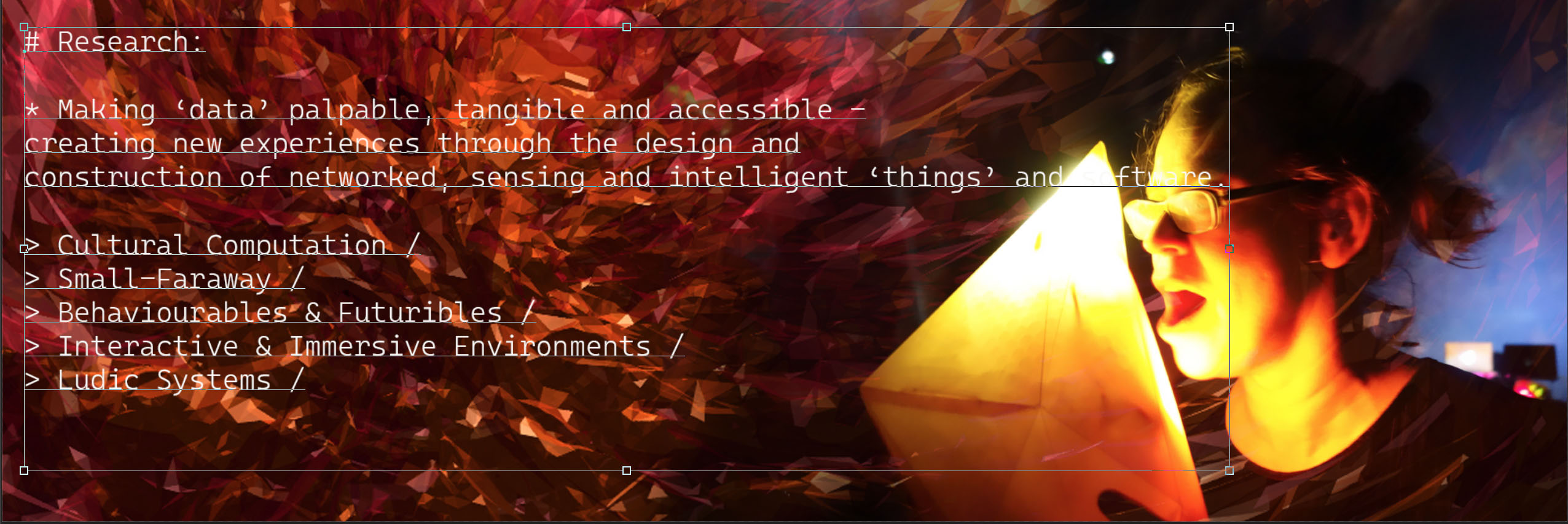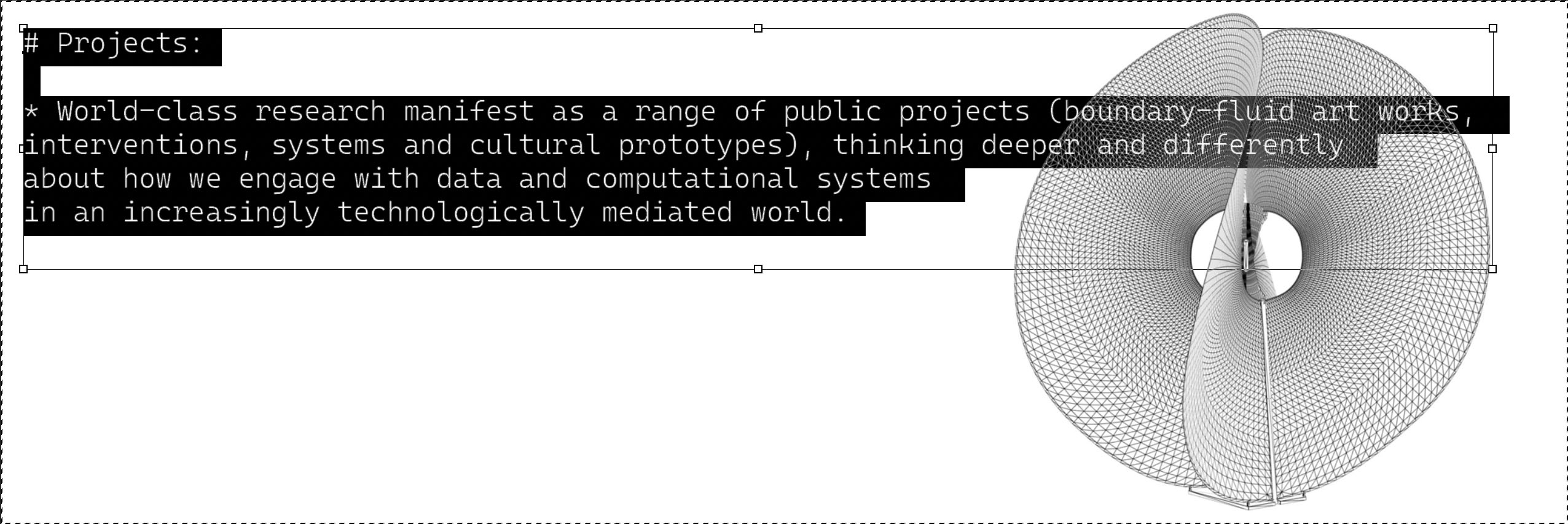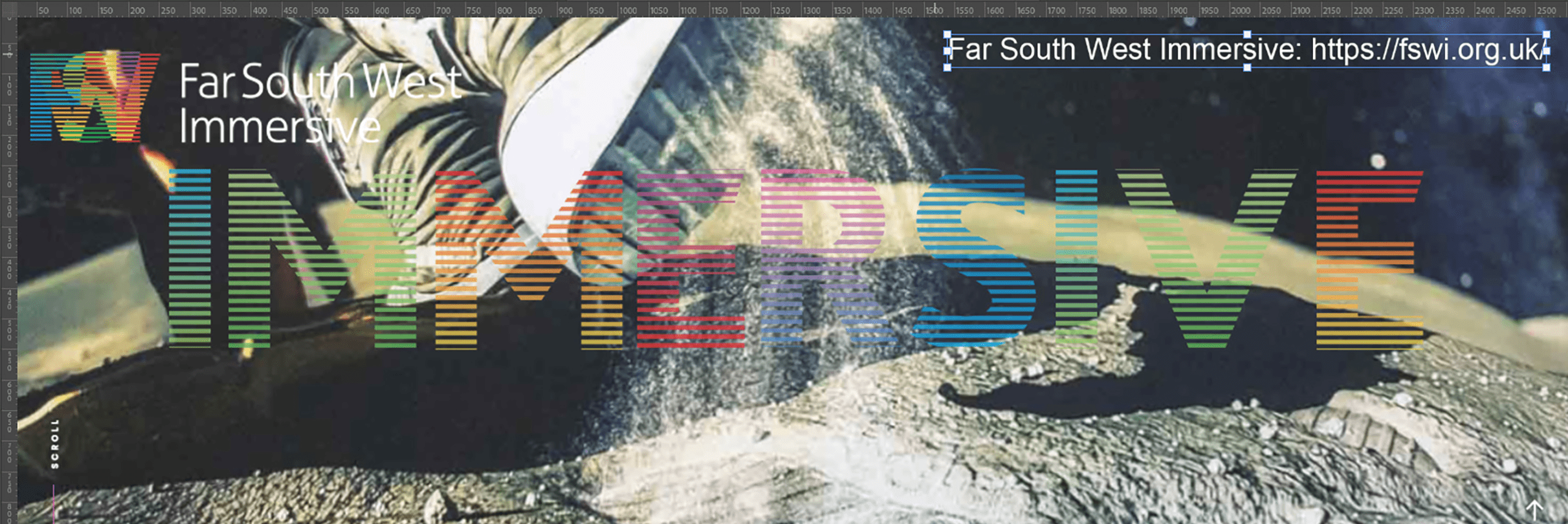i-DAT’s origin story begins with the formation of the notorious BA/BSc Media Lab Arts Programme (established in the School of Computing, 1992). This programme has evolved, mutated and forked over the years in response to technological, social and behavioural change, its genetic code is now manifest in: BA/BSc (Hons) Digital Media Design […dynamic interactive audio-visual projects, underpinned by a deep understanding of coding and design] / BA (Hons) Game Arts and Design […tell epic stories and create living worlds…]…
b-DAT: comprises:

BA/BSc (Hons) Digital Media Design: Digital media include games, websites, apps, interactive experiences and even physical objects. The same underlying processes are at work in all of these, from VR/Mixed Reality to responsive museum installations. You’ll create dynamic interactive audio-visual projects, underpinned by a deep understanding of coding and design. Focused on practical and design skills, you’ll work in project-based contexts, from small test pieces through to live industry briefs and even launching your own business. At the cutting edge of art and design for 28 years the programme has graduates across in digital creative industries worldwide – including IBM, Apple, Nintendo, Spotify and Sony.

BA (Hons) Game Art & Design brings your creativity to the world of computer games. Learn 3D modelling, 2D art and animation, level design and gameplay coding. Games industry experts will guide you through all aspects of game design and development, building a full understanding of the game creation process, and allowing you to specialise in the areas you find most engaging. In a friendly and vibrant setting, you will learn industry-standard software and practices, and have access to the latest hardware, including high-spec gaming PCs and VR headsets. Over three years (or four with an optional industry placement), you will tell epic stories and create living worlds, working individually and teaming-up with other students.
Future Proof: be like {digital} water:
BSc MediaLab Arts provided (established 1992, see below) the genetic material for the evolution of b-DAT, m-DAT and i-DAT’s PGR, Research and Project activities. At its core this DNA is experimental, interdisciplinary, transformative, disruptive, uncanny, volatile, provocative, participatory, ludic and transient. It explores imaginary and (im)material influences on potential futures.
When art is a form of behaviour, software predominates over hardware in the creative sphere. Process replaces product in importance, just as system supersedes structure. Consider the art object in its total process: a behaviourable in its history, a futurible in its structure, a trigger in its effect.
b-DAT existed before the World Wide Web, it has seen Zip Drives, Laser Disks, CD ROM’s, DVD’s and dot-com bubble come and go, it has seen screen resolution/RAM and the Cloud expand infinitely, it has been there, done that and continues to rehearse the future, it is a predictive algorithm.
<We see code as poetry…>
<You will not have done this before…>
<If you have it’s too late, what you did has mutated already…>
<Within six months the soft/hardware you are using will be out of date…>
<Learn how to evolve, be like (digital) water, be Future Proof…>
b-DAT nurtures innovation through digital practices and a synthesis of conventional and emergent methodologies. It cultivates a critical engagement with emergent art and design forms, practices and behaviours, reaching beyond the comfort zone of the creative and cultural industries to actively engage with science and technology agendas. It encourages entrepreneurial aspirations and supports industrial, commercial and community engagement. It is fundamentally playful.
*“Behaviourables and Futuribles.” Control (London) 5 (1970): 3. Reprinted in Theories and Documents of Contemporary Art, ed. Kristine Stiles and Peter Selz, 396 (Berkeley and Los Angeles: University of California Press, 1996).
Portfolio: bits & pieces:
Nizlopi – JCB Song – Laith Bahrani – Animator (2005): Guardian Interview 2006
Shockcube: Jason Cheah, Chris Garner, Chris Le Seuer
Stage 1 Group Project (Own up, who did this?)
Pique, Ben Ashman.
Earthquake Data from the New Scientist, Luke Mears, Jay Macalla.
Artificial Generative Architexture, Billy Bogiatzoglou.
Headache, Joshua Bond.
Flask, Ben Ashman, Saul Hardman, James King, Florian Brückner.
Haptic, Aaron Davies
Alumni: old skool:
i-DAT's Ctrl+Alt+Del Project is building a gallery of x-MLA/DMD/InDe/GAD. If you see this send a pic and link or bio to: mike.phillips@plymouth.ac.uk.
Start-ups: springboard:
and many more…
Future History: rewind…:
BSc MediaLab Arts


BSc (Hons) MediaLab Arts (09/1992), School of Computing, Faculty of Technology, dreamt up by Leslie Kerman (HoS Media & Communications, Exeter Faculty of Art & Design) and Pat Pearce (HoS Computing) following the convergence of Exeter College of Art & Design and Polytechnic South West, to form the University of Plymouth.
MACROMEDIA:


BA/BSc MediaLab Arts secured significant sponsorship from Macromedia which continued until shortly after Adobe acquired the company in 2005.
We are eternally grateful to Tony Tucker for his support during this time. Tony seen here in the first Mediaspace satellite broadcast.
BRIAN ENO:


Brian Eno collaborated with BSc MediaLab Arts during these early years as a Virtual Advisor, contributing to the experimental pedagogy and Mediaspace satellite broadcasts.
Brian can be seen here receiving his Honourary Doctorate in Technology from the University of Plymouth, 1993.
MEDIASPACE:
 Roy Ascott, Brian Eno, et al participate in a series of satellite TV productions and Journal publications. A networked telematic comic.
Roy Ascott, Brian Eno, et al participate in a series of satellite TV productions and Journal publications. A networked telematic comic.
The intent of ‘MEDIASPACE’ [1994-98] was to explore the implications of new media forms and emergent fields of digital practice.
INTERSTICES {1998}:
The INTERSTICES Symposium, ‘The Architecture of Consciousness’ was originally held on August 23 – August 25, 1998 at Port Eliot House, St Germans, Cornwall. The symposium workshop bought together many of the artists included in this application for a 3-day creative ‘hackathon’ of ideas and digital making. The event fed into the entangled digital practice and theory that is now embedded in the history of trans-disciplinary inquiry into art, science, technology. It incorporated the expertise and insights of artists, designers, architects, performers, musicians, writers, scientists, and scholars, from this international community.
https://i-dat.org/interstices/
Submerge {1998-2004}:

The Submerge exhibition began in Plymouth 1998 at the National Marine Aquarium before moving to Bristol Bristol. A student initiated project lead by an incredible team (now leaders in their field), Submerge grew into the South West’s festival for celebrating the best digital new talent to emerge from the regions Universities. From the genius of Birgitte Aga, Cindy Dalgleish, Claire Efergan, Dan Efergan, Nema Hart.
APOLLO Missions:
{these things happened}

Community building during the early days of i-DAT to support the development of the creative tech ecosystem.
MLAX {2003}:
{10 years}

IBM Smarter Planet Lab {2012 -}
https://i-dat.org/smarter-planet/






































































 Alluminati
Alluminati









You must be logged in to post a comment.